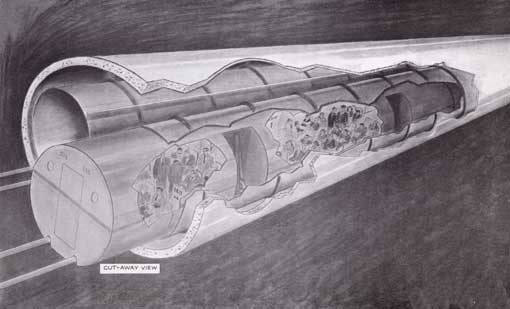Warning: The text reproduced here is a copy of information published elsewhere. This information has either:
- been published freely on the internet and has been cached here as a precaution against future loss of servers and links, or
- been published historically and very few copies of the original text are still available for research purposes.
It is recommended that you look at the original source given below first, and use this text only if that source is not available to you. It is not intended that any text cached here infringe the copyright of the original author. If any copyright owner wishes their text removed from this site, this can be done by contacting the author.
Document summary:
- Title: Transportation Futuristics - Pneumatic Transportation - Bay Area Gravity-Vacuum Transit (Extract)
- Author: Futuristics Exhibit Curator and Project Director: Paul Hernandez; Research: Paul Hernandez, Rita Evans; Captions and Essays: Paul Hernandez, Rita Evans, Rahul Kamath, Sean Mooney.
- Source: http://www.lib.berkeley.edu/news_events/exhibits/futuristics/pt/
- Copyright: The Regents of the University of California
- Date: July 2004
[This extract covers the 1967 proposals for the Bay Area Gravity-Vacuum in the USA. Most of the other content covered schemes already detailed here.]
Transportation Futuristics - Pneumatic Transportation (Extract)
Previous failure did not deter Lockheed engineer L.K. Edwards from trying to resurrect the idea of a high-speed tube transport in the 1960s. Lockheed eventually decided to drop its research in this area, but Edwards persisted, forming Tube Transit, Inc. to exploit "gravity-vacuum transportation." He made presentations to federal and local transportation officials extolling the virtues of his concept, but his pneumatic subway ultimately was no more successful than Alfred Beach's.
...
At the time of this proposal in 1967, BART was well under construction. Bay Area Gravity-Vacuum Transit would have operated alongside BART for much of its route from San Jose to Marin. Between each of its 23 station space, on average about three miles apart, air would be evacuated in the tubes in front of the train, pulling the train on its parabolic course. Exiting the station, the tube slopes downhill until midway between stations, then gradually climbs back uphill to the next station. The trains would attain top speeds of over 210 mph between each stop.
